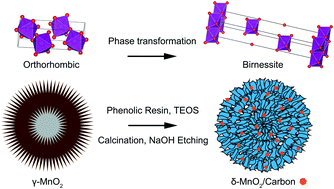Manganese oxides transformed from orthorhombic phase to birnessite with enhanced electrochemical performance as supercapacitor electrodes†
Abstract
Manganese oxides (MnO2) are a class of promising electrode materials for high-performance supercapacitors. Among various possible crystal phases of MnO2, the two-dimensional layered birnessite (δ-MnO2) is considered to facilitate cation intercalation/deintercalation with little structural rearrangement during the charging and discharging process. Here, we report a facile strategy for synthesis of δ-MnO2 with significantly enhanced electrochemical capacitive energy storage performance via phase transformation of orthorhombic MnO2. The resultant δ-MnO2 delivers a specific capacitance of 251.4 F g−1 at a current density of 1 A g−1, which is almost three times higher than that of the original orthorhombic phase. The solid-state flexible asymmetric supercapacitor based on birnessite MnO2 as the positive electrode possesses an operating potential window as high as 2.0 V as well as high energy density and power density. This work demonstrates the post crystal engineering of MnO2 is an effective way to optimize their electrochemical properties.



 Please wait while we load your content...
Please wait while we load your content...